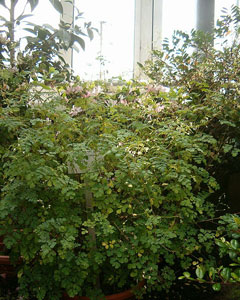 |
|
http://commons.wikimedia.org/wiki/User:BotBln |
 |
|
Translate this page:
Summary
Physical Characteristics

 Boenninghausenia albiflora is a deciduous Shrub growing to 1 m (3ft 3in) by 1 m (3ft 3in).
Boenninghausenia albiflora is a deciduous Shrub growing to 1 m (3ft 3in) by 1 m (3ft 3in).
See above for USDA hardiness. It is hardy to UK zone 8. It is in flower from July to September. The species is hermaphrodite (has both male and female organs).
Suitable for: light (sandy) and medium (loamy) soils and prefers well-drained soil. Suitable pH: mildly acid, neutral and basic (mildly alkaline) soils and can grow in very alkaline soils.
It cannot grow in the shade. It prefers moist soil.
UK Hardiness Map
US Hardiness Map
Synonyms
Ruta alba
Plant Habitats
Woodland Garden Sunny Edge; Cultivated Beds;
Edible Uses
References More on Edible Uses
Medicinal Uses
Plants For A Future can not take any responsibility for any adverse effects from the use of plants. Always seek advice from a professional before using a plant medicinally.
Anodyne Malaria Parasiticide Styptic
The leaves are pounded and applied to cuts and wounds as a styptic and to speed the healing process[218, 272]. They are crushed and placed in the nostrils in the treatment of malaria[218]. The external application of the leaves is also used in the treatment of scabies[272]. The leaf juice is dropped into wounds in order to kill germs[272]. Applied externally to the forehead, the juice is said to relieve headaches, whilst the whole plant is placed under the pillow whilst sleeping to relieve headaches[272]. A decoction of the root is used in the treatment of malaria[218].
References More on Medicinal Uses
The Bookshop: Edible Plant Books
Our Latest books on Perennial Plants For Food Forests and Permaculture Gardens in paperback or digital formats.

Edible Tropical Plants
Food Forest Plants for Hotter Conditions: 250+ Plants For Tropical Food Forests & Permaculture Gardens.
More

Edible Temperate Plants
Plants for Your Food Forest: 500 Plants for Temperate Food Forests & Permaculture Gardens.
More

More Books
PFAF have eight books available in paperback and digital formats. Browse the shop for more information.
Shop Now
Other Uses
References More on Other Uses
Cultivation details
Requires a warm sheltered position in a well-drained soil that is not too dry[11, 138, 200]. Plants are likely to rot if the soil remains too wet in winter[200]. Succeeds on chalk[11, 182]. This species is not hardy in the colder areas of the country, it tolerates temperatures down to between -5 and -10°c[200]. Plants are often cut to the ground in severe winters but they usually regrow from the base[11, 182]. It is best to give the roots a mulch in the winter[11]. A very ornamental but short-lived plant[1]. The leaves are very aromatic[188].
References Carbon Farming Information and Carbon Sequestration Information
Temperature Converter
Type a value in the Celsius field to convert the value to Fahrenheit:
Fahrenheit:
The PFAF Bookshop
Plants For A Future have a number of books available in paperback and digital form. Book titles include Edible Plants, Edible Perennials, Edible Trees,Edible Shrubs, Woodland Gardening, and Temperate Food Forest Plants. Our new book is Food Forest Plants For Hotter Conditions (Tropical and Sub-Tropical).
Shop Now
Plant Propagation
Seed - best sown as soon as it is ripe in a greenhouse in the autumn[188]. Sow stored seed in February to May in a greenhouse[138]. Only just cover the seed. Germination usually takes place within 1 - 3 months at 15°c[138]. When they are large enough to handle, prick the seedlings out into individual pots and grow them on in the greenhouse for at least their first winter. Plant them out into their permanent positions in late spring or early summer, after the last expected frosts. Cuttings of half-ripe wood, July/August in a frame[200].
Other Names
If available other names are mentioned here
Native Range
TEMPERATE ASIA: China (Anhui Sheng, Fujian Sheng, Gansu Sheng, Guangdong Sheng, Guangxi Zhuangzu Zizhiqu, Guizhou Sheng, Hubei Sheng, Hunan Sheng, Jiangsu Sheng, Jiangxi Sheng, Shaanxi Sheng, Sichuan Sheng, Xizang Zizhiqu (southeast), Yunnan Sheng, Zhejiang Sheng), Japan (Honshu, Kyushu, Shikoku), Taiwan TROPICAL ASIA: Bhutan, India (Sikkim, Himachal Pradesh, Jammu and Kashmir, Meghalaya, Nagaland, Uttar Pradesh, West Bengal, Arunachal Pradesh), Nepal, Pakistan (north), Laos, Myanmar, Thailand, Vietnam (north), Indonesia, Malaysia, Philippines
Weed Potential
Right plant wrong place. We are currently updating this section.
Please note that a plant may be invasive in one area but may not in your area so it's worth checking.
Conservation Status
IUCN Red List of Threatened Plants Status :

Growth: S = slow M = medium F = fast. Soil: L = light (sandy) M = medium H = heavy (clay). pH: A = acid N = neutral B = basic (alkaline). Shade: F = full shade S = semi-shade N = no shade. Moisture: D = dry M = Moist We = wet Wa = water.
Now available:
Food Forest Plants for Mediterranean Conditions
350+ Perennial Plants For Mediterranean and Drier Food Forests and Permaculture Gardens.
[Paperback and eBook]
This is the third in Plants For A Future's series of plant guides for food forests tailored to
specific climate zones. Following volumes on temperate and tropical ecosystems, this book focuses
on species suited to Mediterranean conditions—regions with hot, dry summers and cool, wet winters,
often facing the added challenge of climate change.
Read More
Expert comment
Author
(Hook.)Rchb. ex Meisn.
Botanical References
1151200
Links / References
For a list of references used on this page please go here
Readers comment
© 2010, Plants For A Future. Plants For A Future is a charitable company limited by guarantee, registered in England and Wales. Charity No. 1057719, Company No. 3204567.